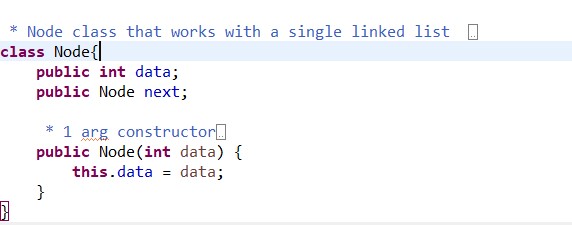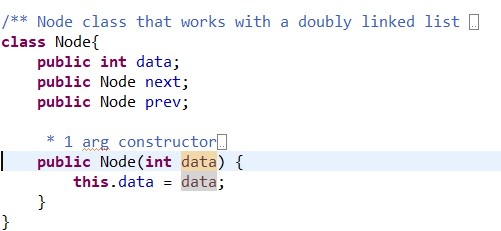
Database System Concepts
7th Edition
ISBN: 9780078022159
Author: Abraham Silberschatz Professor, Henry F. Korth, S. Sudarshan
Publisher: McGraw-Hill Education
expand_more
expand_more
format_list_bulleted
Question
thumb_up100%
What would the difference be in the node classes for a singly linked list, doubly linked list, and a circular linked list? I attached the node classes I have for single and double, but I feel like I do not change enough? Also, I use identical classes for singular and circular node which does not feel right. Any help would be appreciated.

Transcribed Image Text:Node class that works with a single linked list
class Node
public int data;
public Node next;
1 arg constructor
public Node (int data)
this.data = data;

Transcribed Image Text:/** Node class that works with a doubly linked list
class Node
public int data;
public Node next;
public Node prev;
1 arg constructor
public Node (int data)
data;
this.data
Expert Solution
This question has been solved!
Explore an expertly crafted, step-by-step solution for a thorough understanding of key concepts.
This is a popular solution
Trending nowThis is a popular solution!
Step by stepSolved in 2 steps

Knowledge Booster
Learn more about
Need a deep-dive on the concept behind this application? Look no further. Learn more about this topic, computer-science and related others by exploring similar questions and additional content below.Similar questions
- Assume you have a class called Deck which represents a deck of cards using a singly linked lists. Each node is an object of type Card with a field called next where a reference to the next Card is stored. A field from the Deck class called head stores a reference to the card on the top of the deck, and a field called tail stores a reference to the last card, at the bottom of the deck. We can cut a deck of cards by performing what is called a triple cut: the deck is partitioned into three parts and the bottom part is positioned between the first two. You would like to write a method that implements such a cut on your deck data structure. The method will take as input two cards, the first one being the last card of the first part of the deck, and the second being the first one of the third part of the deck. For example, assume a deck contains cards in the following order AC 2C 3C 4C 5C AD 2D 3D 4D 5D After calling tripleCut() on the deck the card, with input a reference to 3C and a…arrow_forwardPlease answer number 1 to 5 as they are linked altogether. Why is encapsulation called Data Hiding? What are the main benefits of using encapsulation in Java? Provide an example of how to achieve encapsulation in Java. Is it possible to declare abstract methods as private? Justify the answer. Is it compulsory for a class, which has been declared as abstract, to have at least one abstract method?arrow_forwardhow would you do this in java?arrow_forward
- Could you help me the following question? The Node structure is defined as follows (we will use integers for data elements): public class Node { public int data; public Node next; public Node previous; } The Double Ended Doubly Linked List (DEDLL) class definition is as follows: public class DEDLL { public int currentSize; public Node head; public Node tail; } This design is a modification of the standard linked list. In the standard that we discussed in class, there is only a head node that represents the first node in the list and each node only contains a reference to the next node in the list until the chain of nodes reach null. In this DEDLL, each node also has a reference to the previous node. The DEDLL also contains a reference to the tail of the list that represents the last node in the list. For example, a DEDLL with 4 elements may have nodes with values 5, 2, 6, and 8 from head to tail. This…arrow_forwardJava Code: Create a Parser class. Much like the Lexer, it has a constructor that accepts a LinkedList of Token and creates a TokenManager that is a private member. The next thing that we will build is a helper method – boolean AcceptSeperators(). One thing that is always tricky in parsing languages is that people can put empty lines anywhere they want in their code. Since the parser expects specific tokens in specific places, it happens frequently that we want to say, “there HAS to be a “;” or a new line, but there can be more than one”. That’s what this function does – it accepts any number of separators (newline or semi-colon) and returns true if it finds at least one. Create a Parse method that returns a ProgramNode. While there are more tokens in the TokenManager, it should loop calling two other methods – ParseFunction() and ParseAction(). If neither one is true, it should throw an exception. bool ParseFunction(ProgramNode) bool ParseAction(ProgramNode) -Creates ProgramNode,…arrow_forwardWrite a Java program for a matrix class that can add and multiply arbitrary two dimensional arrays of integers. Textbook Project P-3.36, pp. 147 Implement Singly Linked List - use textbook Chapter 3.2 as an exaple. Write a main driver to test basic list implementations. Textbook reference : Data structures and algorithms in Java Micheal Goodricharrow_forward
- We have a parking office class for a parking management system. It has dependencies and relations with customer, car, parking lot and parking charge classes. Explain the code by stating implementation decisions, reasons behind those implementation decisions, what you assume was hard or easy to implement, and what helped. public class ParkingOffice {String name;String address;String phone;List<Customer> customers;List<Car> cars;List<ParkingLot> lots;List<ParkingCharge> charges; public ParkingOffice(){customers = new ArrayList<>();cars = new ArrayList<>();lots = new ArrayList<>();charges = new ArrayList<>();}public Customer register() {Customer cust = new Customer(name,address,phone);customers.add(cust);return cust;}public Car register(Customer c,String licence, CarType t) {Car car = new Car(c,licence,t);cars.add(car);return car;}public Customer getCustomer(String name) {for(Customer cust :…arrow_forwardSpecify and implement an iterator method called sortedElements for IntSet. The iterator method sortedElements returns an iterator that will produce each element of the intset in ascending order. The intset cannot be mutated when the iterator is in use. Be sure to specify the iterator method before implementation. Do not forget to give the rep invariant and abstraction function for your implementation. Note: IntSet.java has been provided. You can directly add in the code the specification, the implementation of the iterator method sortedElements, and the inner iterator class. There is a segment of simple testing code for sortedElements in main() close to the end in the provided IntSet.java. The program will not compile until you have properly implemented sortedElements. find the provided code below: https://drive.google.com/open?id=1hANO8kVigGXwFLLJDJQLE5joM1BBeCCnarrow_forwardDefine the abstract base class LinkedSQD_Base using a linked implementation. Indicate whether each field and method should be public, protected, or private, and explain why. Implement each of the ADTs stack, queue, and deque as a class that extends your base class. Repeat parts a and b, but instead define and use the abstract base class ArraySQD_Base using an array-based implementation. Java programarrow_forward
- Draw a class diagram that shows how to use JCF class ArrayList, LinkedList, and Iterator using a UML drawing tool.arrow_forwardI need some help generating a UML diagram from this assigment.arrow_forwarda) Complete the program dependence graphs for the program shown above and 1. Add edges for data dependences in all graphs. 2. Combine the individual SDGs. In particular, you need to add call edges from the call sites tothe invoked method entry node, parameter-in edges from the actual parameters to the formalparameter nodes, and parameter-out edges from the return value ($ret) to the node where theresult is used or from the fields of objects that constitute a side-effect. 3. Add Summary Edges that summarize the effect of parameters on the result. Any summary edgesymbolizes a parameter that has a directed path from its parameter edge to the return value ofthe respective function invocation. b) Determine the 2-phase (context-sensitive) slice of the second call to println(o.get()). Which nodesare marked in the first phase, which in the second?arrow_forward
arrow_back_ios
SEE MORE QUESTIONS
arrow_forward_ios
Recommended textbooks for you
 Database System ConceptsComputer ScienceISBN:9780078022159Author:Abraham Silberschatz Professor, Henry F. Korth, S. SudarshanPublisher:McGraw-Hill Education
Database System ConceptsComputer ScienceISBN:9780078022159Author:Abraham Silberschatz Professor, Henry F. Korth, S. SudarshanPublisher:McGraw-Hill Education Starting Out with Python (4th Edition)Computer ScienceISBN:9780134444321Author:Tony GaddisPublisher:PEARSON
Starting Out with Python (4th Edition)Computer ScienceISBN:9780134444321Author:Tony GaddisPublisher:PEARSON Digital Fundamentals (11th Edition)Computer ScienceISBN:9780132737968Author:Thomas L. FloydPublisher:PEARSON
Digital Fundamentals (11th Edition)Computer ScienceISBN:9780132737968Author:Thomas L. FloydPublisher:PEARSON C How to Program (8th Edition)Computer ScienceISBN:9780133976892Author:Paul J. Deitel, Harvey DeitelPublisher:PEARSON
C How to Program (8th Edition)Computer ScienceISBN:9780133976892Author:Paul J. Deitel, Harvey DeitelPublisher:PEARSON Database Systems: Design, Implementation, & Manag...Computer ScienceISBN:9781337627900Author:Carlos Coronel, Steven MorrisPublisher:Cengage Learning
Database Systems: Design, Implementation, & Manag...Computer ScienceISBN:9781337627900Author:Carlos Coronel, Steven MorrisPublisher:Cengage Learning Programmable Logic ControllersComputer ScienceISBN:9780073373843Author:Frank D. PetruzellaPublisher:McGraw-Hill Education
Programmable Logic ControllersComputer ScienceISBN:9780073373843Author:Frank D. PetruzellaPublisher:McGraw-Hill Education

Database System Concepts
Computer Science
ISBN:9780078022159
Author:Abraham Silberschatz Professor, Henry F. Korth, S. Sudarshan
Publisher:McGraw-Hill Education

Starting Out with Python (4th Edition)
Computer Science
ISBN:9780134444321
Author:Tony Gaddis
Publisher:PEARSON

Digital Fundamentals (11th Edition)
Computer Science
ISBN:9780132737968
Author:Thomas L. Floyd
Publisher:PEARSON

C How to Program (8th Edition)
Computer Science
ISBN:9780133976892
Author:Paul J. Deitel, Harvey Deitel
Publisher:PEARSON

Database Systems: Design, Implementation, & Manag...
Computer Science
ISBN:9781337627900
Author:Carlos Coronel, Steven Morris
Publisher:Cengage Learning

Programmable Logic Controllers
Computer Science
ISBN:9780073373843
Author:Frank D. Petruzella
Publisher:McGraw-Hill Education